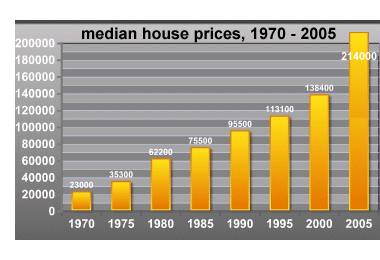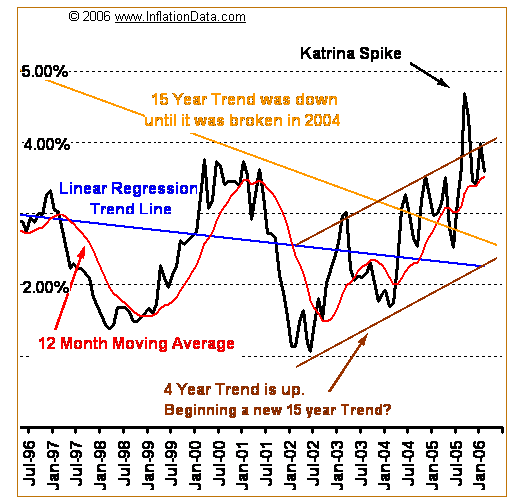

|
| weblog/wEssays archives | home | |
|
A New Inflation Measure: The Grateful Dead Inflation Index (September 22, 2007) Astute reader Michael M. recently wrote: "I would love to see you dedicate an essay to core inflation. how is it calculated? who calculates it? what are the relationships between who calculates it or determines the how and the people who use it for their own economic purposes and even a history of the number."Inflation is a key element in the pervasive campaign to confuse and mislead the U.S. citizenry about the realities of their economy, so it remains a topic worth revisiting. The first stop in understanding "real inflation" should be John Williams' Shadow Government Statistics Analysis Behind and Beyond Government Economic Reporting. To find out more about the government's statistics, a good first step is the Bureau of Labor Statistics.  Before we dig into bogus government-measured inflation, I would like to launch a new
inflation index. In honor of longtime reader/contributor and musician/instrument-maker
Bill Murath, I hereby constitute
The Grateful Dead Inflation Index.
Before we dig into bogus government-measured inflation, I would like to launch a new
inflation index. In honor of longtime reader/contributor and musician/instrument-maker
Bill Murath, I hereby constitute
The Grateful Dead Inflation Index.
My research led me to vintage concert posters, circa the late 60s. I found that 40 years ago in 1967, you could attend a Grateful Dead concert in San Francisco (with several other bands playing as well) for $3 on Friday night, and $2 on Sunday evening. Tickets could be purchases at Rexall Drug Store in Marin, Macy's department store in San Francisco or a record/music store in Berkeley. According to the BLS inflation calculator (found on the BLS page above), that $3 ticket equals $18.70 in today's (debased) dollars, and the $2 ticket works out to be $12.50. Here is the question: can you go to a Phil Lesh and Friends concert, ot indeed, any top-name rock/pop/hip-hop band for $12.50 or $18.70? Last time I checked, $12.50 was roughly what Ticketmaster charges for handling the purchase and delivery of your ticket. Phil Lesh's band is currently touring, and the tickets are reasonable by today's standards: $55 each. Add the rip-off Ticketmaster fee and parking, and you're up around $75 each: a far cry from the price "official inflation" should dictate: less than $20. OK, so you say the GD is not a good measure. Fine, let's move on the Strolling Bones, a.k.a. The Rolling Stones, rock-n-roll's most enduring stadium-rock franchise. At the top of their game in 1969, it cost $4.50 for a regular seat in the stadium and $6.50 for the best seats in the house to see The Stones live. The best seat in the house in today's money: $36.89. Can you go to a Stones concert nowadays for less than $100? Dream on. OK, so the shows today have more props and pizzazz. Fine--but does all that staging triple the cost? If so, why? And you can be sure that Rexall Drugs in Marin didn't charge you the equivalent of $12.50 to issue you a ticket, either. The point is: official inflation calculations are woefully inadequate in assessing "real life" declines in the dollar's purchasing power. By the Grateful Dead Inflation Index, our purchasing power has dropped by 2/3 more than "official" inflation suggests. Apologists like to point out that jeans and athletic shoes are now much cheaper than they were in 1969, and that PCs weren't even invented, etc. True. So the $50 I spend on jeans and shoes a year used to cost, say $150. Whoopie. But the GDII (Grateful Dead Inflation Index) cuts through the malarky and double-speak canards to reach the ugly truth: most things cost more now--a lot more.  The key bit of double-speak is the "core rate of inflation," i.e. inflation minus the
essentials of food and energy. This blatant manipulation dates from the Nixon era, when
government officials were desperate to hide the rising inflation of the early 70s. They hit
upon the card-trick of "core inflation" to distract people from the realities hitting them
in the face at the gas pump and supermarket.
The key bit of double-speak is the "core rate of inflation," i.e. inflation minus the
essentials of food and energy. This blatant manipulation dates from the Nixon era, when
government officials were desperate to hide the rising inflation of the early 70s. They hit
upon the card-trick of "core inflation" to distract people from the realities hitting them
in the face at the gas pump and supermarket.
Incredibly, the American media and public bought the lie hook, line and sinker, and continue to do so today. I explained some of the current legerdemaine/slight of hand in previous entries: Why Inflation Appears Low (June 2005) Inflation and Housing: Calculating the Bust (May 25, 2006) The Housing - Inflation Connection (April 25, 2006) Here is an excerpt from the last entry: One little-understood result of the housing bubble is its massive distortion of the Consumer Price Index, i.e. the rate of inflation. Why is this important? Let's start with an example.  Let's say Joe and Suzie Citizen bought a house in 2004 which they'd previously rented
for $1,500 a month. Their monthly mortgage, insurance and property taxes total $2,500.
The effect on the CPI of the extra $1,000 a month? $0
Let's say Joe and Suzie Citizen bought a house in 2004 which they'd previously rented
for $1,500 a month. Their monthly mortgage, insurance and property taxes total $2,500.
The effect on the CPI of the extra $1,000 a month? $0
Let's say Suzie's folks' house just got re-appraised, and thanks to the housing bubble, their property tax bill is 40% higher--about a $1,000 more a year. (If you think this sounds high, think again). The effect of this higher property tax payment on the CPI? $0. Let's say Joe and Suzie's neighbor was one of the 25% of buyers who bought their house with an exotic "interest-only," low-interest rate mortgage back in 2003. His annual mortgage rate has just been reset from 4.5% to 7.5%, causing his mortgage payment to rise by over $1,000 a month. The effect on the CPI of the extra $1,000 a month? $0 Wait a minute. You mean these huge rises in housing expenses have zero effect on inflation? How is that possible? As Alan Abelson explained in a May 30, 2005 Barron's column: Shelter, you see, which accounts for about 30% of the core CPI is measured not by the dictates of the marketplace, how much houses actually fetch when they're sold, but by a strange -- make that perverse -- yardstick called owners' equivalent rent. Homeowners are asked how much they think they could get were they to rent their abodes.In one important sense, money is a commodity like any other. The cost of money --that is, the cost of borrowing money--rises and falls, just like the costs of other commodities. When the cost drops--when interest rates fall--then that has a deflationary effect on the CPI. You get the same good or service for less money. Conversely, when interest rates rise--as they are now--then they have an inflationary effect. You're paying more for the exact same service/good--in this case, your house. But in the current CPI calculation, the actual costs for 70% of the population--homeowners--is completely ignored in favor of "market rate" rents. Here are the numbers used to figure the CPI (taken from the Bureau of Labor Statistics abstract titled why inflation as stated in CPI doesn't match your reality:) Expenditure category --------------------------------- Food and beverages 15.7 Housing 40.9 Apparel 4.4 Transportation 17.1 Medical care 5.8 Recreation 6.0 Education/communication 5.8 Other goods & services 4.3 --------------------------------- Total, all items 100.0  The BLS website provides this detailed explanation of the housing component of CPI:
rent and owner's equivalent rent. Basically, the BLS says that rents are far more stable
a measure than mortgage rates, which rise and fall to a much greater degree than rents. While
this makes sense, it ignores the fact that only 30% of the citizenry rent, and that
most of those renters are in the lower income brackets. Most renters simply cannot
afford to buy a house; as a consequence, rents can only rise as fast as renters' incomes--
and as noted here and elsewhere, income for American workers has been flat for the past 5 years.
The BLS website provides this detailed explanation of the housing component of CPI:
rent and owner's equivalent rent. Basically, the BLS says that rents are far more stable
a measure than mortgage rates, which rise and fall to a much greater degree than rents. While
this makes sense, it ignores the fact that only 30% of the citizenry rent, and that
most of those renters are in the lower income brackets. Most renters simply cannot
afford to buy a house; as a consequence, rents can only rise as fast as renters' incomes--
and as noted here and elsewhere, income for American workers has been flat for the past 5 years.
For more on the 34 million renters in the U.S., please read this report by Joint Center for Housing Studies of Harvard University: America's Rental Housing. (Note: this is a large PDF file which may take some time to load if you have a dialup Internet connection.) The report notes that 3 million units of rental housing were constructed from 1993-2003, even as the number of renters held steady at 34 million. In other words, homeownership increased, and the supply of rental housing exceeds the demand--the classic formula for keeping rents low. As you can see, Abelson underestimated the role of housing in the CPI--it's actually over 40%. (To find the official rate of inflation for any year or series of years, go to the BLS website and select the "inflation calculator" in the upper left heading.) So what does all this mean in the real world? Just this: the official inflation rate of about 2.5% per year has grossly miscalculated the true costs of the nation's housing. As house values leapt above their historic ratio to rents, as property taxes have skyrocketed, as mortgage rates are rising, as mortgage resets dramatically raise millions of household's expenses--the CPI reflects nothing but rents which are depressed by massive overbuilding. Here is an CNN/Money article on the issue: Double jeopardy for landlords; "Slowing housing prices and a stagnant rental market have landlords squeezed from both sides." But despite this gross mis-reporting of actual housing expenses, inflation is beginning to rise--with enormous consequences for the U.S. economy and the housing market. 
Why? Because we depend on foreigners to buy our Treasury bonds and the trillions of dollars of mortgage-backed securities which have enabled low mortgage rates. Once inflation is perceived as being 5% (never mind it's probably 6-7%), who in their right mind would buy a mortgage-backed security paying 6%? And we all know what's been propping up the bubble--low interest rates. Though most home buyers are unaware of it, their mortgage rate isn't set by the Federal Reserve--it's set by the bond market. And once the bond market grasps that the actual rate of inflation far exceeds the official rate, then mortgage rates will rise. How high? Historically, bond buyers expect at least 2% above inflation, though 3 or 4% is typical. If inflation is actually running at 6%, then a mortgage rate of 10% would be well within historical norms. For more on inflation-related articles, use the search box in the right sidebar, or type "inflation + oftwominds.com" in your favorite search engine. There are lots of other distortions in the inflation calculation; are your medical expenses only 5% of your expenses? If so, then you're not self-employed, uninsured or ill. The list of other distortions is long enough to fill a book. The question we should ask is: why is the calculation so blatantly distorted to reduce actual inflation to a much lower number? Who benefits from such manipulation? Who suffers? The answers reveal much about the political and financial realities which are so deviously and purposefully masked by "offical" statistics. Thank you, Katherine H., ($25) for your much-valued donation via check to this humble site. I am greatly honored by your encouragement and readership. All contributors are listed below in acknowledgement of my gratitude. For more on this subject and a wide array of other topics, please visit my weblog. copyright © 2007 Charles Hugh Smith. All rights reserved in all media. I would be honored if you linked this wEssay to your site, or printed a copy for your own use. |
||
| weblog/wEssays | home |